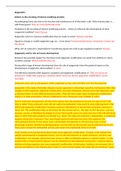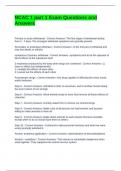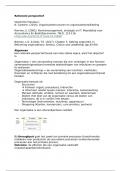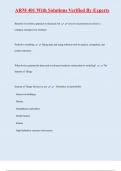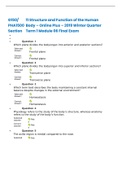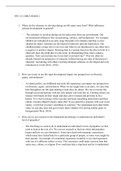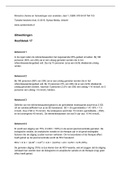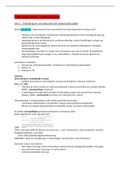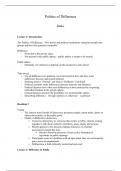Epigenetics
Defects in the encoding of histone-modifying proteins
Housekeeping Genes are vital to the function and maintenance of all the body’s cells. What characteristic is … with these genes? They are transcriptionally active
Mutations in the encoding of histone modifying proteins … shown to influence the development of what congenital condition? Heart Disease
Epigenetics refers to chemical modification that are made to what? Histones and DNA
Signals to change or modify epigenetic tags are … from where? Environmental factors. Hormones, Contact (all the above)
What sort of molecule is responsible for transferring signals into cells to gen regulatory proteins? Kinases
Epigenetics and its role on human development
Research has provided support for the theory that epigenetic modification can result from deficient in utero nutrition causing? Obesity diabetes and CAD. During which stage of human development does the role of epigenetics have the greatest impact on the development of epigenetic abnormalities? In utero
The difference between DNA sequence mutations and epigenetic modifications is? They are said to be pluripotent. Unlike DNA sequence mutations which cannot be altered, epigenetic modifications can be reversible. Embryonic stem cells are pluripotent, which originated as mass cells with blast cyst (not the placenta)
Epigenetics is the study of heritable changes in gene expression or phenotype caused by mechanisms other than changes in DNA sequences. Epigenetic modifications can cause individuals with the same DNA sequences (such as identical twins) to have different disease profiles. There are three major types of epigenetic modifications (Figure 6-1): DNA methylation: Histone modification Micro-ribonucleic acids (miRNAs or miRs): Early in embryonic development, all cells of the embryo have the potential to become any type of cell in the fetus or adult. These embryonic stem cells are said to be pluripotent. A key event in early embryogenesis is the differential epigenetic modification (including extensive methylation) of specific DNA nucleotide sequences in these cells. This modification helps to determine the fate of each cell (i.e., the type of cell it becomes, such as a myocyte, neuron, or fibroblast) by helping to ensure that specific genes are expressed only in the cells and tissue
types in which their gene products are needed (e.g., factor VIII expression primarily in hepatocytes, or dopamine
receptor expression in neurons). Thus, even though nearly all cells have the same DNA sequence, the transcriptional activity of most genes varies substantially and depends on cell and tissue type. A small percentage of genes, termed housekeeping genes, are necessary for the function and maintenance of all cells. These genes escape the methylation process and remain transcriptionally active in all cells.
Much remains to be learned about factors that cause epigenetic modifications. Findings so far indicate that specific environmental or nongenetic factors, such as diet and exposure to certain chemicals, can drive such modifications. For example, alcohol has been shown to affect methylation patterns in animal models,5 so the harmful effects of fetal alcohol exposure may be mediated through epigenetic mechanisms. Maternal dietary deficiency during pregnancy may cause epigenetic modifications of fetal genes, leading to an increased risk of obesity and diabetes in the offspring later in life.6 In some animal models, the insulin-like growth factor 2 gene (IGF2) is a target of these epigenetic modifications. Although the observed changes in methylation status of CpG
sequences in these genes are typically small, it is possible that they affect phenotypic development. The hereditary transmission of epigenetic changes to successive generations has been termed epigenetic transgenerational inheritance. If demonstrated to occur in humans, transgenerational inheritance could have important implications for disease and disease prevention. The best evidence for epigenetic effects on disease risk comes from studies of human cancer
Robust experimental observations are clarifying the roles of epigenetic states in determining cell fates and disease phenotypes. The well-documented involvement of epigenetic abnormalities in carcinogenesis and the mounting evidence for these epigenetic changes in other common diseases (discussed in other chapters) will likely elucidate possibilities for reversing the epigenetic abnormalities and preventing their establishment in utero.
Totipotent cells and its ability to differentiate into any type of cell
Which embryonic stem cell characteristic is referred to as a totipotent? Ability to differentiate into any type of somatic cell. Examples of two totipotent cells are? Spores and zygotes
What is a Totipotent cell? One of the most important stem cell as they have the potential to develop in any cell found in the human body. Are all cells Totipotent cells? Only the morula cells are. Prader-Willi syndrome and Angelman syndrome?
What characteristic of Prader-Willi syndrome is not a characteristic of Angelman syndrome?
Mid-Mild-to-Moderate retardation
Inherited from the father
A child with Prader-Willi syndrome has been hospitalized. Which assessment findings does the nurse expect with this syndrome? Insatiable hunger – morbid obesity Prader-Willi syndrome will have short stature, hypotonia, small hands, small feet, obesity, hypogonadism, inverted V-shape upper lip
The nurse is examining an 8-year-old boy with chromosomal abnormalities. Which sign, or symptom suggests the boy has Angelman syndrome? Observation shows jerky ataxic movements Angelman is SEVERE mental retardation, seizures, ataxic gait, and bouts of uncontrolled laughter Is inherited by the mother A well-known disease example of imprinting is associated with a deletion of about 4 million base pairs (Mb) of the long arm of chromosome 15. When this deletion is inherited from the father, the child manifests Prader-Willi syndrome, whose features include short stature, hypotonia, small hands and feet, obesity, mild to moderate mental retardation, and hypogonadism. The same 4-Mb deletion, when inherited from the mother, causes Angelman syndrome, which is characterized by severe mental retardation, seizures, and an ataxic gait
Defects in the encoding of histone-modifying proteins
Housekeeping Genes are vital to the function and maintenance of all the body’s cells. What characteristic is … with these genes? They are transcriptionally active
Mutations in the encoding of histone modifying proteins … shown to influence the development of what congenital condition? Heart Disease
Epigenetics refers to chemical modification that are made to what? Histones and DNA
Signals to change or modify epigenetic tags are … from where? Environmental factors. Hormones, Contact (all the above)
What sort of molecule is responsible for transferring signals into cells to gen regulatory proteins? Kinases
Epigenetics and its role on human development
Research has provided support for the theory that epigenetic modification can result from deficient in utero nutrition causing? Obesity diabetes and CAD. During which stage of human development does the role of epigenetics have the greatest impact on the development of epigenetic abnormalities? In utero
The difference between DNA sequence mutations and epigenetic modifications is? They are said to be pluripotent. Unlike DNA sequence mutations which cannot be altered, epigenetic modifications can be reversible. Embryonic stem cells are pluripotent, which originated as mass cells with blast cyst (not the placenta)
Epigenetics is the study of heritable changes in gene expression or phenotype caused by mechanisms other than changes in DNA sequences. Epigenetic modifications can cause individuals with the same DNA sequences (such as identical twins) to have different disease profiles. There are three major types of epigenetic modifications (Figure 6-1): DNA methylation: Histone modification Micro-ribonucleic acids (miRNAs or miRs): Early in embryonic development, all cells of the embryo have the potential to become any type of cell in the fetus or adult. These embryonic stem cells are said to be pluripotent. A key event in early embryogenesis is the differential epigenetic modification (including extensive methylation) of specific DNA nucleotide sequences in these cells. This modification helps to determine the fate of each cell (i.e., the type of cell it becomes, such as a myocyte, neuron, or fibroblast) by helping to ensure that specific genes are expressed only in the cells and tissue
types in which their gene products are needed (e.g., factor VIII expression primarily in hepatocytes, or dopamine
receptor expression in neurons). Thus, even though nearly all cells have the same DNA sequence, the transcriptional activity of most genes varies substantially and depends on cell and tissue type. A small percentage of genes, termed housekeeping genes, are necessary for the function and maintenance of all cells. These genes escape the methylation process and remain transcriptionally active in all cells.
Much remains to be learned about factors that cause epigenetic modifications. Findings so far indicate that specific environmental or nongenetic factors, such as diet and exposure to certain chemicals, can drive such modifications. For example, alcohol has been shown to affect methylation patterns in animal models,5 so the harmful effects of fetal alcohol exposure may be mediated through epigenetic mechanisms. Maternal dietary deficiency during pregnancy may cause epigenetic modifications of fetal genes, leading to an increased risk of obesity and diabetes in the offspring later in life.6 In some animal models, the insulin-like growth factor 2 gene (IGF2) is a target of these epigenetic modifications. Although the observed changes in methylation status of CpG
sequences in these genes are typically small, it is possible that they affect phenotypic development. The hereditary transmission of epigenetic changes to successive generations has been termed epigenetic transgenerational inheritance. If demonstrated to occur in humans, transgenerational inheritance could have important implications for disease and disease prevention. The best evidence for epigenetic effects on disease risk comes from studies of human cancer
Robust experimental observations are clarifying the roles of epigenetic states in determining cell fates and disease phenotypes. The well-documented involvement of epigenetic abnormalities in carcinogenesis and the mounting evidence for these epigenetic changes in other common diseases (discussed in other chapters) will likely elucidate possibilities for reversing the epigenetic abnormalities and preventing their establishment in utero.
Totipotent cells and its ability to differentiate into any type of cell
Which embryonic stem cell characteristic is referred to as a totipotent? Ability to differentiate into any type of somatic cell. Examples of two totipotent cells are? Spores and zygotes
What is a Totipotent cell? One of the most important stem cell as they have the potential to develop in any cell found in the human body. Are all cells Totipotent cells? Only the morula cells are. Prader-Willi syndrome and Angelman syndrome?
What characteristic of Prader-Willi syndrome is not a characteristic of Angelman syndrome?
Mid-Mild-to-Moderate retardation
Inherited from the father
A child with Prader-Willi syndrome has been hospitalized. Which assessment findings does the nurse expect with this syndrome? Insatiable hunger – morbid obesity Prader-Willi syndrome will have short stature, hypotonia, small hands, small feet, obesity, hypogonadism, inverted V-shape upper lip
The nurse is examining an 8-year-old boy with chromosomal abnormalities. Which sign, or symptom suggests the boy has Angelman syndrome? Observation shows jerky ataxic movements Angelman is SEVERE mental retardation, seizures, ataxic gait, and bouts of uncontrolled laughter Is inherited by the mother A well-known disease example of imprinting is associated with a deletion of about 4 million base pairs (Mb) of the long arm of chromosome 15. When this deletion is inherited from the father, the child manifests Prader-Willi syndrome, whose features include short stature, hypotonia, small hands and feet, obesity, mild to moderate mental retardation, and hypogonadism. The same 4-Mb deletion, when inherited from the mother, causes Angelman syndrome, which is characterized by severe mental retardation, seizures, and an ataxic gait

